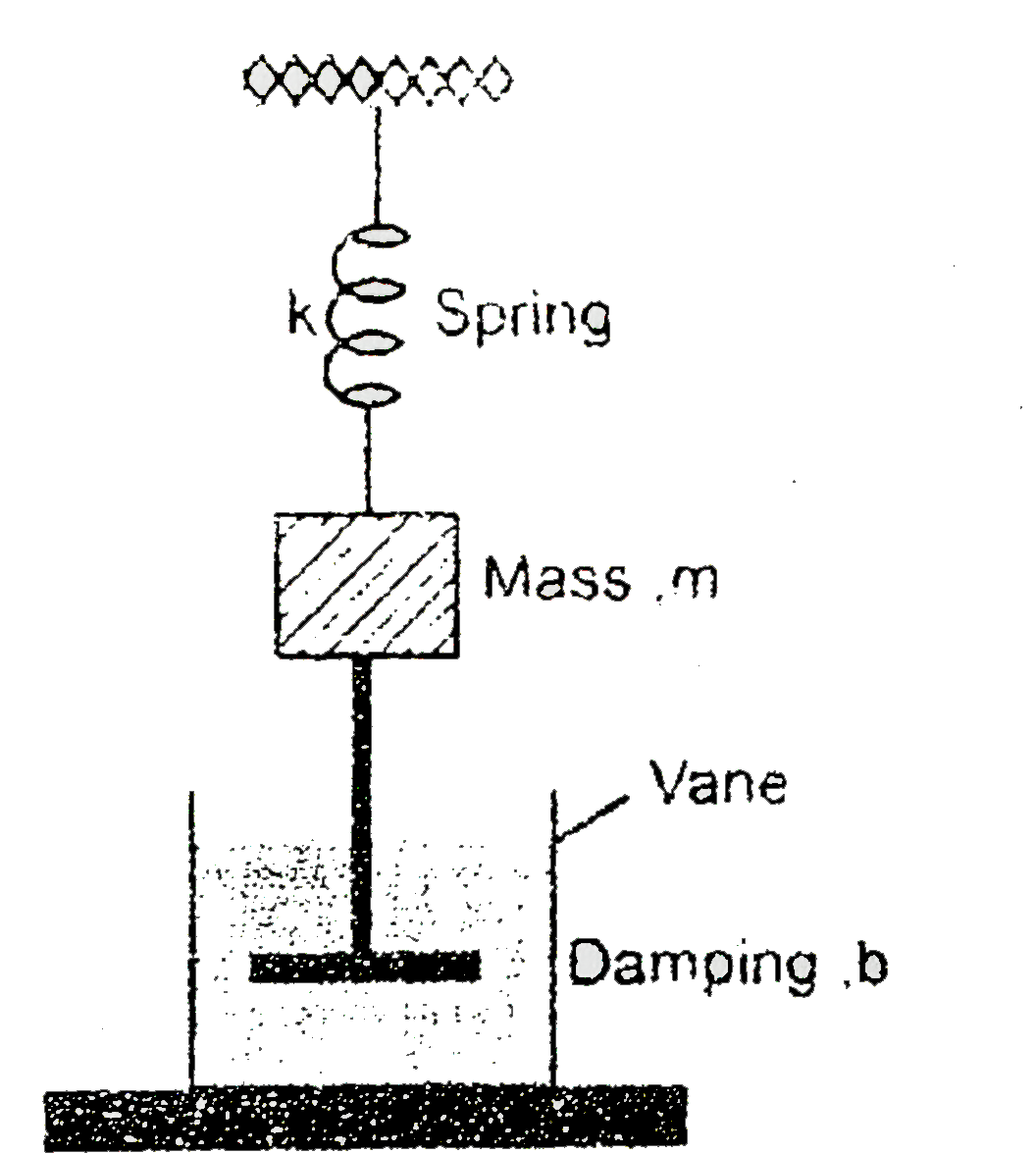For a damped oscillation m=500 gm ,k=100 N/m,b=75 gm/sec. What is the ratio of amplitue of damped oscillation to the intial amplitude at the end of 20 cycles
[given1e0.675=0.5,1e0.51=0.6]
0.6
0.51
0.4
none
The correct Answer is:B
To find the ratio of the amplitude of damped oscillation to the initial amplitude at the end of 20 cycles, we can follow these steps:
Step 1: Convert mass from grams to kilograms
Given:
- Mass m=500 gm
- Convert to kg:
m=5001000=0.5 kg
Step 2: Identify the spring constant
Given:
- Spring constant k=100 N/m
Step 3: Convert damping constant from grams/second to kg/second
Given:
- Damping constant b=75 gm/sec
- Convert to kg/sec:
b=751000=0.075 kg/sec
Step 4: Calculate the time period of one complete cycle
The formula for the time period T of a damped harmonic oscillator is:
T=2π√mk
Substituting the values:
T=2π√0.5100=2π√0.005=2π⋅110=2π10=π5
Step 5: Calculate the total time for 20 cycles
The total time t for 20 cycles is:
t=20⋅T=20⋅π5=4π
Step 6: Calculate the ratio of the amplitude of damped oscillation to the initial amplitude
The ratio yy0 is given by:
yy0=e−btm
Substituting the values:
yy0=e−0.075⋅4π
Step 7: Simplify the exponent
Calculating the exponent:
0.075⋅4π≈0.075⋅12.566≈0.942
Thus,
yy0=e−0.942
Step 8: Use the given values to find the ratio
From the problem statement, we know:
e−0.675=0.5ande−0.51=0.6
Since e−0.942 is not provided, we can approximate it or use the known values. However, we can conclude that:
yy0≈0.5 (based on provided values)
Final Answer
The ratio of the amplitude of damped oscillation to the initial amplitude at the end of 20 cycles is approximately:
yy0≈0.5
Given:
- Mass m=500 gm
- Convert to kg:
m=5001000=0.5 kg
Given:
- Spring constant k=100 N/m
Given:
- Damping constant b=75 gm/sec
- Convert to kg/sec:
b=751000=0.075 kg/sec
The formula for the time period T of a damped harmonic oscillator is:
T=2π√mk
Substituting the values:
T=2π√0.5100=2π√0.005=2π⋅110=2π10=π5
The total time t for 20 cycles is:
t=20⋅T=20⋅π5=4π
The ratio yy0 is given by:
yy0=e−btm
Substituting the values:
yy0=e−0.075⋅4π
Calculating the exponent:
0.075⋅4π≈0.075⋅12.566≈0.942
Thus,
yy0=e−0.942
From the problem statement, we know:
e−0.675=0.5ande−0.51=0.6
Since e−0.942 is not provided, we can approximate it or use the known values. However, we can conclude that:
yy0≈0.5 (based on provided values)
The ratio of the amplitude of damped oscillation to the initial amplitude at the end of 20 cycles is approximately:
yy0≈0.5
Similar Questions
The amplitude of a lightly damped oscillator decreases by 4.0% during each cycle. What percentage of mechanical energy of the oscillator is lost in each cycle?
View SolutionIn dampled oscillation , the amplitude of oscillation is reduced to half of its initial value of 5 cm at the end of 25 osciallations. What will be its amplitude when the oscillator completes 50 oscillations ?
Hint :A=A0e−bt2m , let T be the time period of oxcillation
Case -I :A02=A0e−bx25T2m
or 12=e−25bT2m ......(i)
Case -IIA=A0e−b×50T2m
A0(e−25bT2m)2
Use euation (i) to find a .
View Solution
Knowledge Check
A simple harmonic oscillator has a frequency of 2.5 Hz and an amplitude of 0.05m. What is the period of the oscillations?
A0.4sB0.2sC8sD20s
The amplitude of a particle in damped oscillation is given by A=A0e−ktwheresymbolshaveusualmean∈gsifattimet=4s,theamplitudeishalfof∈itialamplitudethentheamplitudeis1/8 of initial value t=
View SolutionIn damped oscillations, the amplitude is reduced to one-third of its initial value a0 at the end of 100 oscillations. When the oscillator completes 200 oscillations ,its amplitude must be
View SolutionFor the damped oscillator shown in Fig, the mass of the block is 200g,k=80Nm−1 and the damping constant b is 40gs−1 Calculate
The period of oscillation

View SolutionLength of a stretched wire is 2m. It is oscillating in its fourth overtone mode. Maximum amplitude of oscillations is 2mm. Find amplitude of oscillation at a distance of 0.2m from one fixed end.
View SolutionA uniform rod of length 2.0 m is suspended through an end and is set into oscillation with small amplitude under gravity. The time period of oscillation is approximately
View SolutionGiven the equetion for a wave on a string
y=0.03sin(3x−2t)
where y and x are in meters and t is in seconds.
(a). At t=0, what are the values of the displacement at x=0,0.1 m,0.2 m, and 0.3m ?
(b). At x=0.1 m what are the values of the displacement at t=0,0.1 s, and 0.2 s?
(c ) what is the equetion for the velocity of oscillation of the particles of the string?
(d). what is the maximum velocity of oscillation?
(e). what is the velocity of propagation of the wave?
View SolutionThe amplitude of a damped oscillator decreases to 0.9 times ist oringinal magnitude in 5s, In anothet 10s it will decrease to α times its original magnitude, where α equals to .
View Solution
